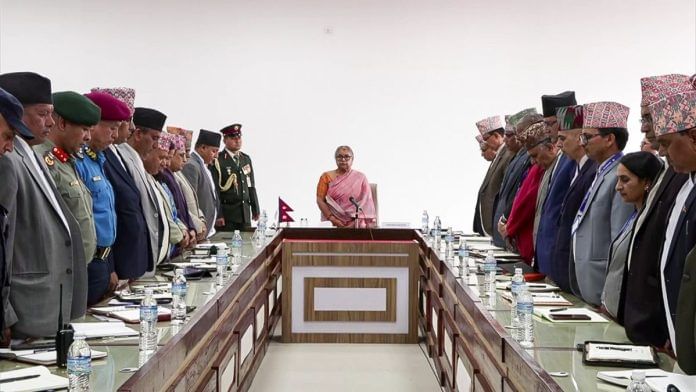Finally, Nepal’s new Prime Minister has an X account. In her first post, Prime Minister Sushila Karki, presumably through her office, announced three new social media handles representing the Prime Minister’s Office on X, Facebook, and Instagram. These accounts were created on 05 October—almost four weeks after the elected government of KP Sharma Oli was toppled by Gen Z-led protests against nepotism, corruption, censorship, a social media ban, an internet blackout, and paralysing governance.
But something unusual about these new accounts has caught social media’s attention. The most common question is, why were new accounts created at all? Why couldn’t the Prime Minister’s Office recover the old, official ones?
The blame chatter
For a country where Gen Z youth peacefully united against a social media ban and later violently protested an internet blackout, it is telling that the new Prime Minister reportedly has no access to the official handles used during the Oli era.
In the first weeks of Prime Minister Karki’s tenure, hundreds of fake accounts impersonating her emerged on X and other platforms. Taking note of the matter, her office clarified that the Prime Minister was not operating any official accounts. A major Nepali media outlet, KhabarHub, quoted her office: “It has been found that fake accounts have been created in the Prime Minister’s name and are sharing posts and news. We request everyone not to be confused by such activities”
Most social media buzz accuses former PM Oli and his party’s Deputy General Secretary Bishnu Rijal of retaining control of the official handles, refusing to share passwords, and thereby fuelling a political vendetta.
One X user asked bluntly: “What is stopping them from arresting @kpsharmaoli, who is using the Prime Minister’s old handle @PM_nepal_himself…and the so-called advisor bag-carrier @BishnuRimal, bringing back the handle?” Another user wrote: “Oh, @BishnuRimal brother, don’t you need to hand over the Prime Minister’s official handle? Don’t you feel even a little ashamed?”
Others raised the larger concern: who now controls the official and verified @PM_nepal_ handle?
Also read: UNGA was Nepal’s missed opportunity. It can’t ignore foreign policy during domestic turmoil
Missed digital safety?
While many accused Oli of withholding access to official accounts, some users praised PM Karki for taking the bold step of starting new handles. But questions also surfaced about digital safety and protocol.
Incidentally, her Facebook and Instagram accounts were created using a Gmail ID — pmonepalnew@gmail.com — instead of a government domain.
This raises concerns about cybersecurity, data protection, and whether the government is adhering to its own protocols for official communication.
Beyond the social media chatter lies a broader question: can a Prime Minister, hailed as a beacon of reform and accountability, deliver on her promises if her office cannot even regain access to an official social media account?
An X user quipped: “We have to believe that the Prime Minister, who cannot restore a single Twitter account, will bring back the money that corrupt leaders have looted from the country.”
Beyond passwords
This may not be a minor “digital hiccup” but a symptom of something deeper — whether governance in Nepal is still hostage to entrenched party networks that lie dormant and work behind the scenes in government offices.
For Gen Z, whose political awakening has been shaped online, a Prime Minister’s social media accounts are not a personal diary but a reflection of the state within the country and abroad. The inability to access verified accounts reveals an alarming failure of institutional process.
If transitions of power can erase digital identities so easily, what else could be lost in the shuffle—files, decisions, accountability? This is not just about passwords. It is about the lack of planning by her advisors.
Also read: The key difference between India and China’s response to Gen-Z protests in Nepal
The websites Included
The state of the Prime Minister’s official website tells its own troubling story about the government’s digital priorities. The site appears poorly maintained—except for the names and photos of Prime Minister Karki and the Chief Secretary, no bios of the leadership are available. The Council of Ministers page remains blank. Even more telling, the “former Prime Ministers“ section still lists Pushpa Kamal Dahal alias Prachanda as the last PM instead of Oli.
Ironically, the Nepali version of the website is updated, but the English version lags behind. One could argue that the interim government’s priority is holding fresh elections by March 2026, not updating English-language portals. But has Nepal deprioritised global visibility to investors, diplomats, and foreign governments? Relying on auto-translation hardly inspires confidence.
Managing digital platforms may seem like a small issue. But it reflects a larger worry about governance, which requires attention to detail, foresight, and institutional capacity. This is especially true in a country where Gen Z youth toppled a government through social media-driven protests, demanding systemic change.
Nepal’s state apparatus quickly needs to figure out how it wants to move forward. If passwords can be lost in transition, what happens to power itself?
Rishi Gupta is a commentator on global affairs. Views are personal.
(Edited by Prashant)






